Demolition Contractors Grafton
Top Demolition Companies in Grafton
Receive 3 FREE Demolition Services quotes for your project today! Compare profiles, reviews, accreditations, portfolio, etc... and choose the best service.
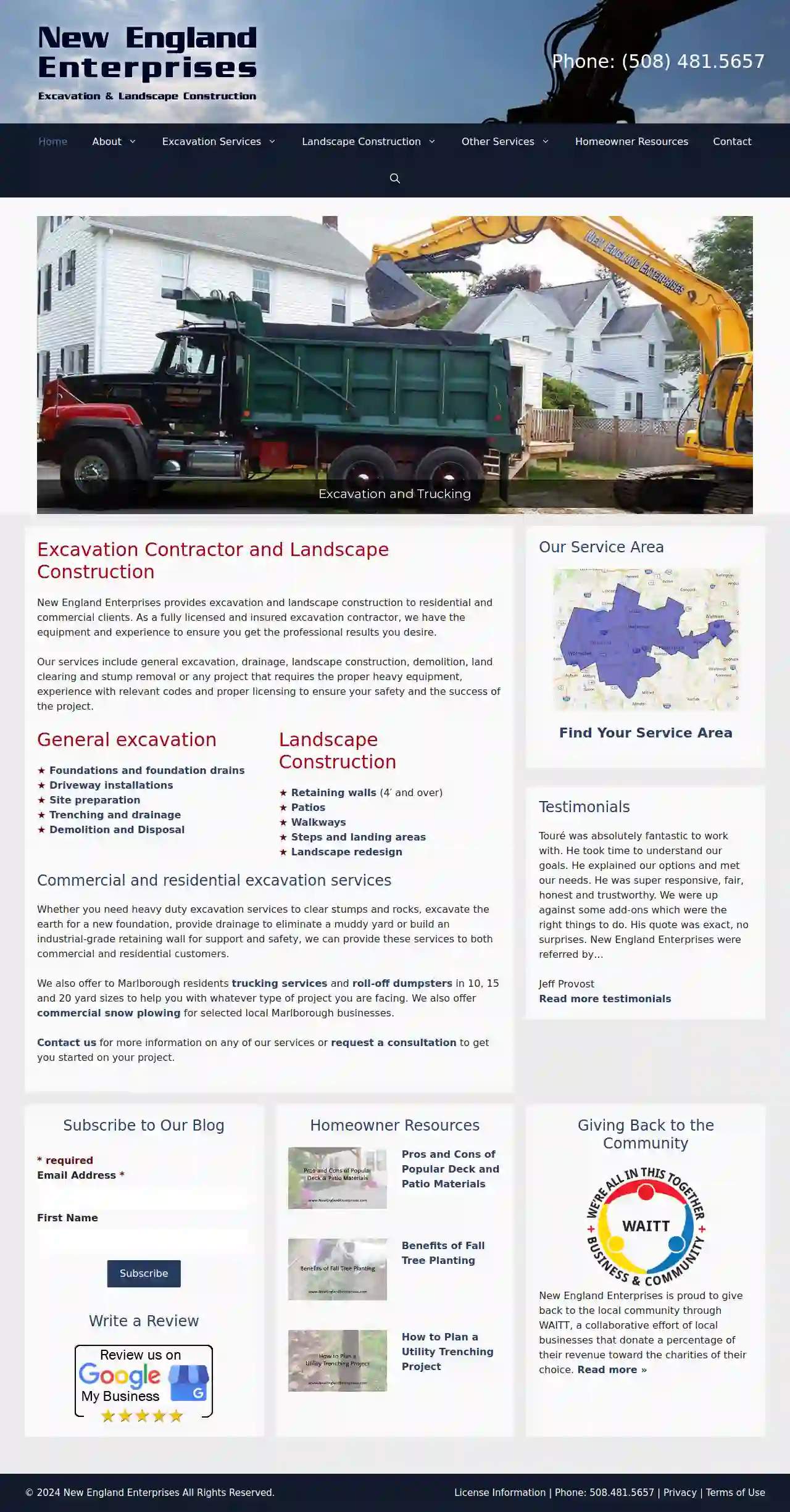
New England Enterprises
510 reviewsPlymouth, USExcavation Contractor and Landscape Construction New England Enterprises provides excavation and landscape construction to residential and commercial clients. As a fully licensed and insured excavation contractor, we have the equipment and experience to ensure you get the professional results you desire. Our services include general excavation, drainage, landscape construction, demolition, land clearing and stump removal or any project that requires the proper heavy equipment, experience with relevant codes and proper licensing to ensure your safety and the success of the project. Whether you need heavy duty excavation services to clear stumps and rocks, excavate the earth for a new foundation, provide drainage to eliminate a muddy yard or build an industrial-grade retaining wall for support and safety, we can provide these services to both commercial and residential customers. We also offer to Marlborough residents trucking services and roll-off dumpsters in 10, 15 and 20 yard sizes to help you with whatever type of project you are facing. We also offer commercial snow plowing for selected local Marlborough businesses. Contact us for more information on any of our services or request a consultation to get you started on your project.
- Services
- Why Us?
- Testimonials
- Gallery
Get Quote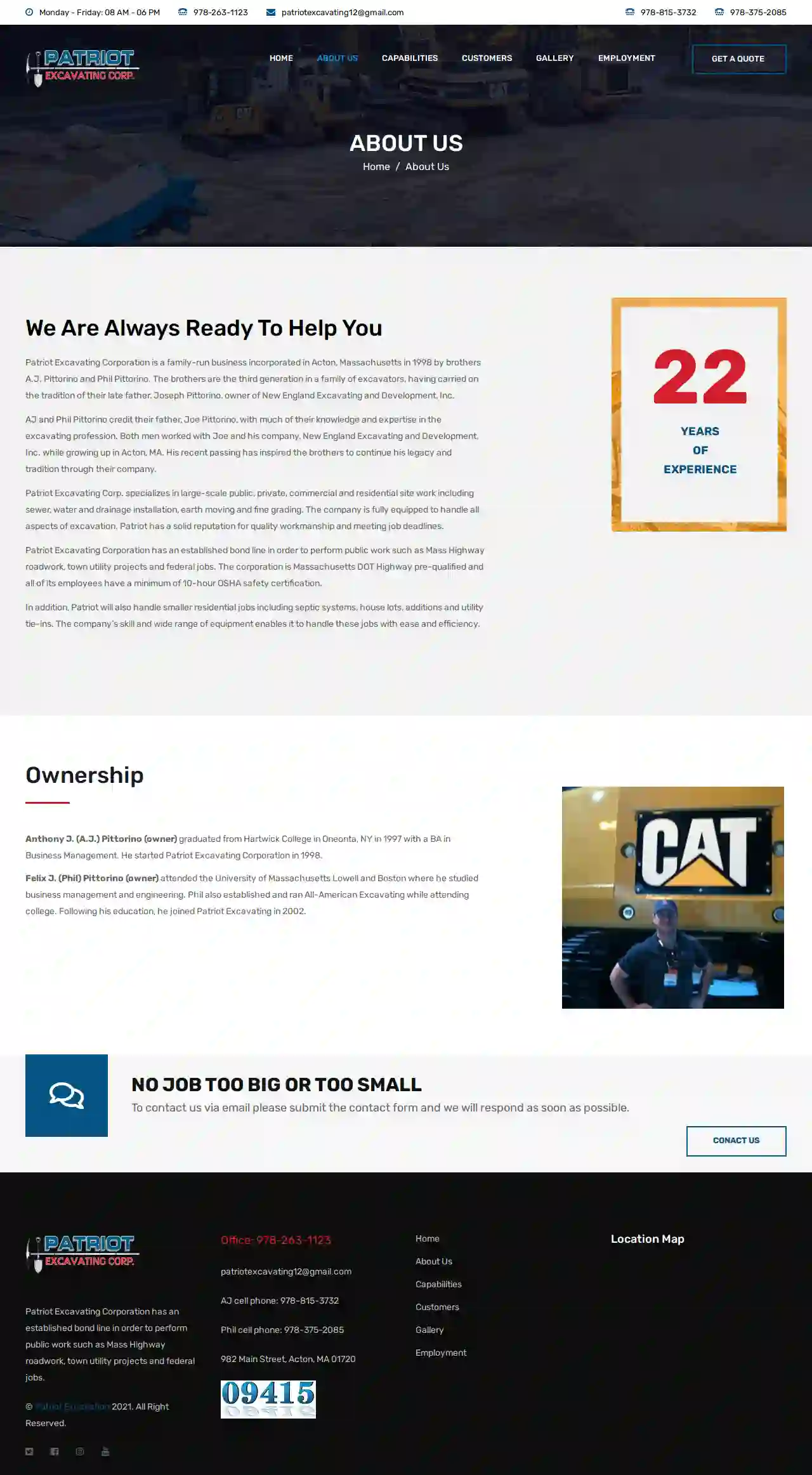
Patriot Excavation
982 Main Street, Acton, 01720, USAbout Us Patriot Excavating Corporation is a family-run business incorporated in Acton, Massachusetts in 1998 by brothers A.J. Pittorino and Phil Pittorino. They are the third generation in a family of excavators, carrying on the tradition of their late father, Joseph Pittorino, owner of New England Excavating and Development, Inc. A.J. and Phil Pittorino credit their father, Joe Pittorino, with much of their knowledge and expertise in the excavating profession. Both men worked with Joe and his company, New England Excavating and Development, Inc. while growing up in Acton, MA. His recent passing has inspired the brothers to continue his legacy and tradition through their company. Our Services Patriot Excavating Corp. specializes in large-scale public, private, commercial and residential site work including sewer, water and drainage installation, earth moving and fine grading. The company is fully equipped to handle all aspects of excavation. Patriot has a solid reputation for quality workmanship and meeting job deadlines. Patriot Excavating Corporation has an established bond line in order to perform public work such as Mass Highway roadwork, town utility projects and federal jobs. The corporation is Massachusetts DOT Highway pre-qualified and all of its employees have a minimum of 10-hour OSHA safety certification. In addition, Patriot will also handle smaller residential jobs including septic systems, house lots, additions and utility tie-ins. The company’s skill and wide range of equipment enables it to handle these jobs with ease and efficiency. Our Team Anthony J. (A.J.) Pittorino (owner) graduated from Hartwick College in Oneonta, NY in 1997 with a BA in Business Management. He started Patriot Excavating Corporation in 1998. Felix J. (Phil) Pittorino (owner) attended the University of Massachusetts Lowell and Boston where he studied business management and engineering. Phil also established and ran All-American Excavating while attending college. Following his education, he joined Patriot Excavating in 2002.
- Services
- Why Us?
- Our Team
- Gallery
Get Quote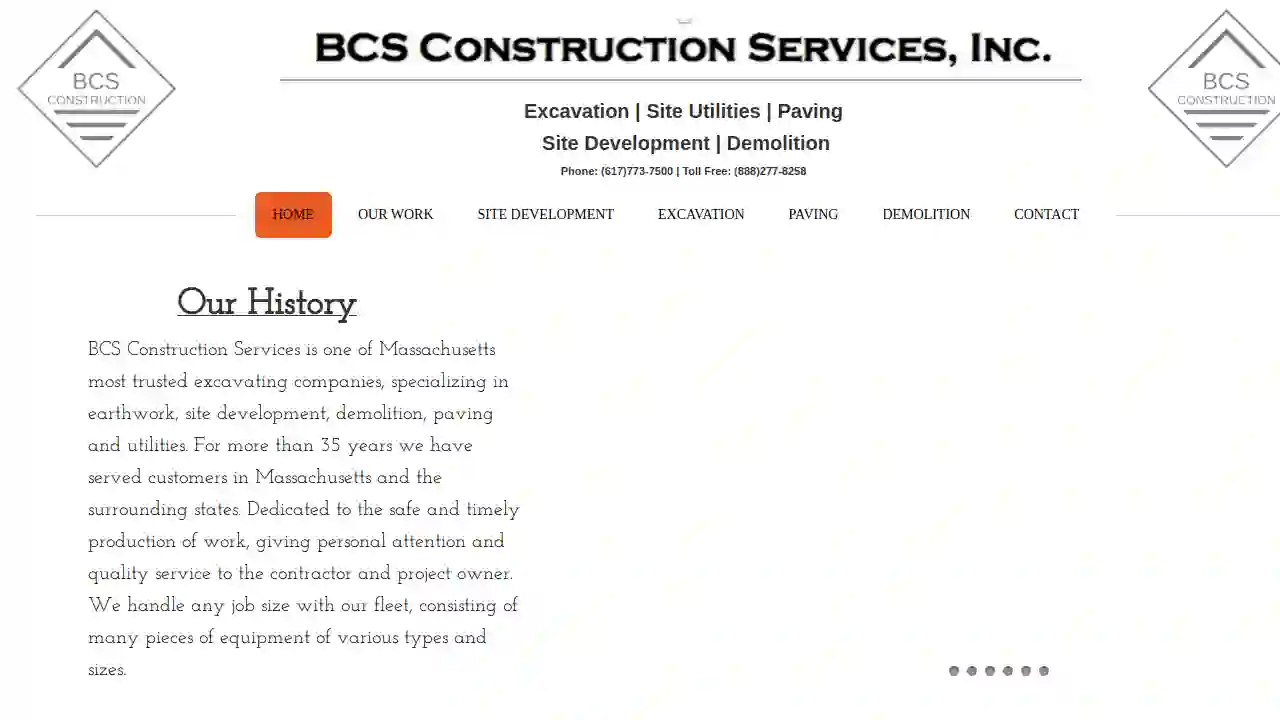
Boston Contracting Services
859 Willard Street, Suite 400, Quincy, 02169, USBCS Construction Services is a trusted excavating company in Massachusetts, specializing in earthwork, site development, demolition, paving, and utilities. For over 35 years, we've served customers in Massachusetts and surrounding states. We're dedicated to safe and timely work, providing personal attention and quality service to contractors and project owners. We handle any job size with our fleet of diverse equipment. Our Core Focus We specialize in a wide range of services, including: Roads Parking Lots Grading and Compacting Industrial Manhole & Catch Basins Municipal Paving Car Dealerships Demolition Our Services We offer a comprehensive range of services, including: Site Development Excavation Paving Demolition Utilities Licenses & Certifications BCS Construction Services holds various construction and engineering licenses in cities and towns throughout Massachusetts. We are licensed to perform all municipal and commercial work, and we hold licenses to operate interstate when necessary. Our team also holds various safety licenses from OSHA. Insurance & Bonding BCS Construction Services is capable of meeting most insurance requirements for mid to large-size commercial jobs. We also hold various bonds with cities and towns throughout Massachusetts. Other Services BCS Construction Services has provided expert witness testimony to assist in various construction and real estate-related activities. Please contact us directly if you are interested in this service.
- Services
- Why Us?
- Gallery
Get Quote
Luciano's Excavation Inc
56 reviews41 Taunton Green Suite 102, Taunton, 02780, USABOUT US Lucianos Excavation is a family owned and operated business. We provide experience and guidance throughout the construction process. With Cost Effective Solutions, we apply best business practices to complete and meet your needs. Luciano Ribeiro came over to America in 1985, from the Cape Verde islands. After ten years of building boats for Boston Whaler, he decided he needed a new career and turned to construction in 1995. He started from the ground up, as a laborer, doing what ever he could to soak up all the knowledge around him. After a year of hard work and staying late off the clock to learn how to move the equipment, they finally gave him a chance to operate machinery. Starting off in the loader gave him a chance to get the feel for heavy equipment, after 3 years of gaining experience he was finally able to get into the excavator. 25 years later he has now become one of the best excavator operators in New England, and his quality of work never goes unnoticed! From dredging ponds to putting in revetments, there is nothing he is unable to do in an excavator!
- Services
- Why Us?
- Gallery
Get Quote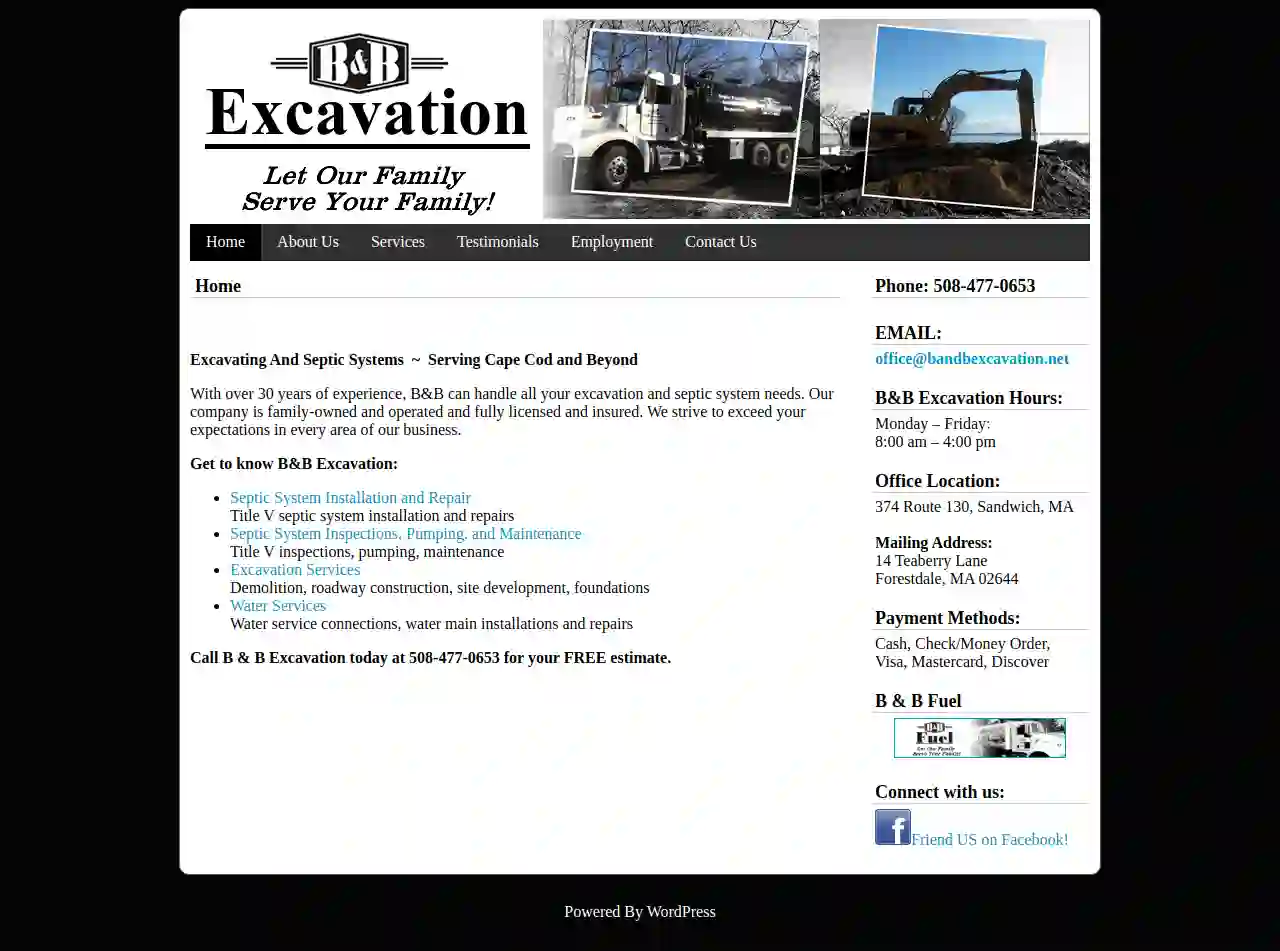
B & B Excavation
4.826 reviews374 Route 130, Sandwich, 02644, USExcavating And Septic Systems ~ Serving Cape Cod and Beyond With over 30 years of experience, B&B can handle all your excavation and septic system needs. Our company is family-owned and operated and fully licensed and insured. We strive to exceed your expectations in every area of our business. Get to know B&B Excavation:
- Services
- Why Us?
- Gallery
Get Quote
M. DiStasio Excavation Contractors
95 Washington St., Tewksbury, 01876, USOur Mission. Our mission is to provide each and every client with a service that reflects our values of integrity, perfection, and authenticity. We treat each and every project with the same care, ensuring they are completed to the highest degree. The History. For nearly a decade, M. DiStasio Excavation Contractors have served the greater New England Area with an immense amount of passion! We’re constantly growing and expanding operations and look forward to an incredibly exciting future! Supporting Our Community We proudly support our nation's first responders and all service members. M. DiStasio excavation prides itself in our involvement with the local community as well as Law Enforcement, Fire, and EMS. Alongside our ongoing support of first responders, we’re deeply involved with the “Slow Down – Move Over” movement which encourages driver awareness and response to pull-over and breakdown situations often found on our nation’s roadways. Slow down, move over.
- Services
- Why Us?
- Gallery
Get Quote
Consigli Construction Co Inc
4.720 reviews100 Cummings Center, Suite 2200, Beverly, USOur Story A history rooted in tradition, a future led with vision. Learn More > Who We Are A fourth generation company founded in 1905, Consigli offers the strength and stability of a large construction manager and the flexibility of a start-up. Our people love what they do and it shows—in their entrepreneurial spirit, in their desire to create environments that strengthen our communities, in the enduring relationships they build and in the pride they take in their craft. A Legacy Built on Accountability Consigli was founded upon the principles of dedication, hard work and commitment to craft. As we evolve, these things will never change. See the Story > Our People, Our Difference We don’t just assign people to projects—we challenge them to learn, lead, teach, problem-solve and rise to every occasion. Meet the People Who Make It Work > Projects That Move Us It’s our purpose to be builders—it’s ingrained in who we are. We create environments and relationships that strengthen our communities and enrich the ways people live, work, learn, heal and play. Let’s Get to Work >
- Services
- Why Us?
- Gallery
Get Quote
Deloury Construction Co Inc
4.25 reviews100 Burtt Road, Suite G01, Andover, 01810, USTrusted General Contractor and Excavator in Boston, MA The next time you need help with construction, excavation, or demolition services, count on Deloury Industries. Since 1963, our company has been accomplishing the most demanding construction challenges in the state and across our nation, ensuring our commercial and industrial customers meet the ever-changing demands of the marketplace. Why Choose Us? Our company is founded on the values of honest work, community engagement, and continuous improvement. With these values, strong leadership, and the dedication of our highly skilled employees, we've built on our history of success decade after decade. Moreover, we always aim to exceed your expectations in every project facet and bring life to your developments efficiently, safely, and within budget. Hire Us for Your Next Project Let our team make your project the next challenge we overcome. Our reliable, affordable, and trusted company is always ready to handle any of your construction projects. For inquiries about services, contact us and speak with our general contractor. We hope to be of service to you soon! Be Part of Our Team Jumpstart your career with us, and be part of a company that values its workers. Deloury Industries is now hiring truck drivers. To learn more about our career opportunities, get in touch with us.
- Services
- Why Us?
- Gallery
Get Quote
Amato Excavation
53 reviewsPlymouth, USAbout Amato Excavation Founded in 2021 by Anthony Amato, Amato Excavation was born out of a vision to transform landscapes through precision excavation services. From humble beginnings, we have grown into a reliable and trusted name in the Middlesex Region, with an ever-expanding list of satisfied clients. Our passion for excavating the past and shaping the future drives us to continuously enhance our techniques and equipment, ensuring that we stay at the forefront of the excavation field. Our Mission To provide the highest quality excavation services while maintaining the utmost integrity, safety, and environmental consciousness. We strive to exceed our clients' expectations, no matter the scale or complexity of the project. Our team of skilled professionals is committed to completing each task with precision, efficiency, and attention to detail. What Sets Us Apart: Experience: With years of hands-on experience, our team possesses the knowledge and expertise necessary to handle a wide range of excavation projects with confidence and finesse. Cutting-edge Technology: We invest in state-of-the-art equipment and advanced technology to ensure that our excavation services are efficient, precise, and completed in a timely manner. Safety First: The safety of our clients, employees, and the community is our top priority. We are fully licensed and insured, and adhere to strict safety protocols to maintain a clean, hazard-free work environment. Environmental Responsibility: We are mindful of the impact our work may have on the environment. As stewards of the land, we take measures to minimize disruption and ecological footprint during excavation. Customer-Centric Approach: At Amato Excavation, we believe in open communication and collaboration with our clients. We listen to their needs, offer expert advice, and tailor our services to meet their specific requirements.
- Services
- Why Us?
- Gallery
Get Quote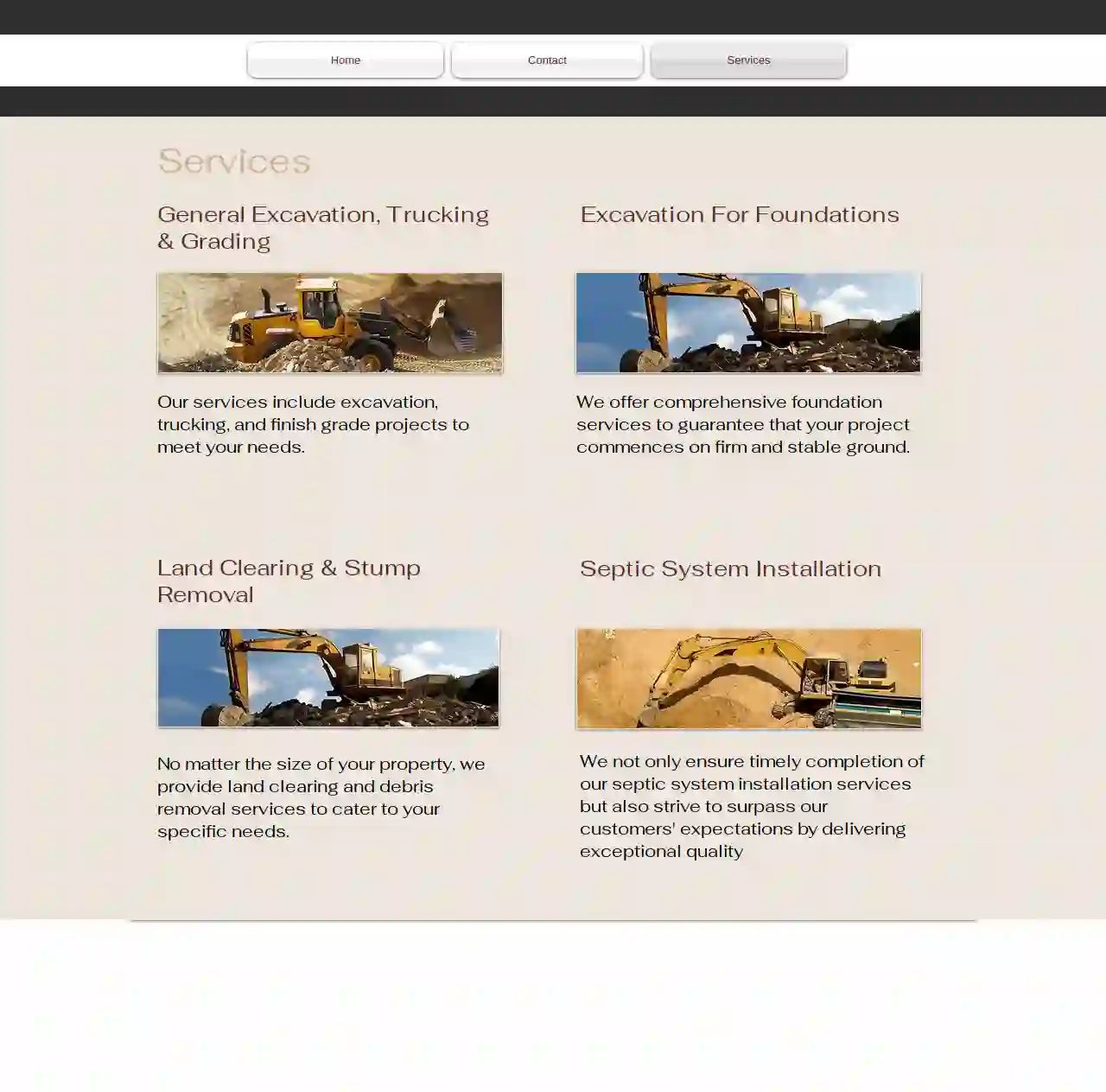
Coastline Excavation Plymouth, Ma
51 reviewsPlymouth, USCoastline Excavation: Your Trusted Partner for Excavation, Trucking, and Grading Coastline Excavation is a reputable company dedicated to providing high-quality excavation, trucking, and grading services to meet your project needs. We understand the importance of a solid foundation for any construction project, and our team of experienced professionals is committed to delivering exceptional results. From initial site preparation to final grading, we handle every aspect of your project with precision and care. Our modern equipment and skilled operators ensure efficient and timely completion, minimizing disruption to your schedule. We take pride in our commitment to customer satisfaction. Our team is dedicated to providing clear communication, competitive pricing, and a personalized approach to every project. We work closely with our clients to understand their specific requirements and ensure their complete satisfaction.
- Services
- Why Us?
- Gallery
Get Quote
Over 22,076+ Excavation Contractors in our network
Our excavation experts operate in Grafton & surroundings!
ExcavationHQ has curated and vetted the Best Excavation Contractors near Grafton. Find a trustworthy business today.
Frequently Asked Questions About Demolition Contractors
- 'Can I see proof of your licensing and insurance?' Verify their credentials and coverage.
- 'What experience do you have with projects like mine?' Ensure they have relevant expertise.
- 'Can you provide references from past clients?' Check their reputation and customer satisfaction.
- 'What are your safety protocols?' Prioritize contractors who emphasize safety.
- 'How will you handle hazardous materials?' Ensure they have proper procedures for asbestos or lead abatement.
- 'What is your timeline for completing the project?' Understand the project duration.
- 'How will you manage noise, dust, and debris?' Discuss mitigation measures for minimizing disruption.
- 'What are your payment terms?' Clarify payment schedules and any required deposits.
- Permits and Regulations: Obtain all necessary demolition permits and comply with local building codes and environmental regulations.
- Contracts: Have a clear and comprehensive contract with the demolition contractor outlining the scope of work, payment terms, and liabilities.
- Environmental Laws: Comply with environmental laws regarding hazardous material removal, waste disposal, and pollution control.
- Neighboring Property Rights: Respect neighboring property rights and take measures to prevent damage or disruption to adjacent properties.
- Worker Safety: Adhere to worker safety regulations and provide a safe working environment for demolition crews.
- General Liability Insurance: Covers bodily injury or property damage to third parties caused by the contractor's negligence.
- Workers' Compensation Insurance: Provides benefits to workers injured on the job.
- Pollution Liability Insurance: Covers costs associated with environmental contamination caused by demolition activities.
- Professional Liability Insurance: Protects against claims of negligence or errors in professional services, such as demolition planning or consulting.
What is asbestos abatement?
What questions should I ask a demolition contractor before hiring them?
What are the legal considerations for demolition projects?
What is the importance of insurance in demolition projects?
What is asbestos abatement?
What questions should I ask a demolition contractor before hiring them?
- 'Can I see proof of your licensing and insurance?' Verify their credentials and coverage.
- 'What experience do you have with projects like mine?' Ensure they have relevant expertise.
- 'Can you provide references from past clients?' Check their reputation and customer satisfaction.
- 'What are your safety protocols?' Prioritize contractors who emphasize safety.
- 'How will you handle hazardous materials?' Ensure they have proper procedures for asbestos or lead abatement.
- 'What is your timeline for completing the project?' Understand the project duration.
- 'How will you manage noise, dust, and debris?' Discuss mitigation measures for minimizing disruption.
- 'What are your payment terms?' Clarify payment schedules and any required deposits.
What are the legal considerations for demolition projects?
- Permits and Regulations: Obtain all necessary demolition permits and comply with local building codes and environmental regulations.
- Contracts: Have a clear and comprehensive contract with the demolition contractor outlining the scope of work, payment terms, and liabilities.
- Environmental Laws: Comply with environmental laws regarding hazardous material removal, waste disposal, and pollution control.
- Neighboring Property Rights: Respect neighboring property rights and take measures to prevent damage or disruption to adjacent properties.
- Worker Safety: Adhere to worker safety regulations and provide a safe working environment for demolition crews.
What is the importance of insurance in demolition projects?
- General Liability Insurance: Covers bodily injury or property damage to third parties caused by the contractor's negligence.
- Workers' Compensation Insurance: Provides benefits to workers injured on the job.
- Pollution Liability Insurance: Covers costs associated with environmental contamination caused by demolition activities.
- Professional Liability Insurance: Protects against claims of negligence or errors in professional services, such as demolition planning or consulting.